As Connor Bedard broke into the NHL recently, I thought it would be fun to investigate player careers based on how they began.
Casual observation leads us to believe that the better players start their careers at younger ages. Connor McDavid had a PR-Elite season in his Age-19 season, as did Steven Stamkos. Auston Matthews had a PR-Star season at the tender age of 19. Patrick Kane and Tim Stutzle are among 29 players who had a PR-First5 season at 19.
For this article I will create statistics that measure career starts and career quality, using Productivity Rating (PR) as the basis for the new statistics. As usual, the statistics I create will consist of a score and a category.
Along the way you’ll see a lot of career Productivity Rating charts. I am talking about careers, after all.
Players Used to Establish the New Statistics
I needed players whose entire careers must be in the “available statistics” era, which started in 2007-08. The statistics used to calculate PR are not publicly available for earlier seasons. This means that only players born in 1989 or later can be used; they would have been 18 in the 2007-08 season.
I will be using a player’s first good season and the subsequent season to establish his career start statistics. Career quality statistics require a player to have played a minimum of six “useable” seasons. You’ll see what I mean by useable soon enough.
Career Start Statistics: ST-Score, ST-Category
I decided to measure the start of a player’s career by using his first good season and the subsequent season. I defined “good” as a season with a PR-Regular or better rating. (The higher ratings are PR-First5, PR-Star, and PR-Elite.)
There are 1,575 players who were born in 1989 or later and who have played at least one game in the NHL. Of those, only 595 have had a “good season”. Some players have played a lot of seasons and not had even one season rate PR-Regular or better: amongst others, there are Matt Martin, Kyle Clifford, and Ryan Reaves.
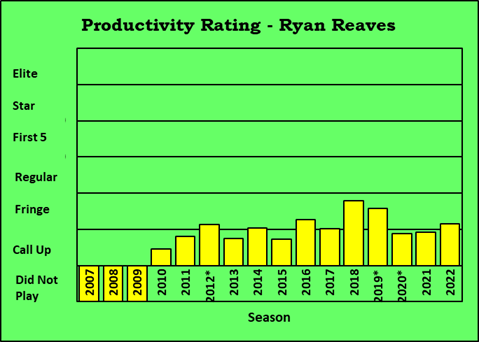
Of the 595 players who have had at least one good season, 51 of them had their first good season in 2022-23. They were excluded from further consideration as they have not yet had a subsequent season to their first good one. There are 543 players who have a measurable career start.
ST-Score, a number that represents the strength of the start of a player’s career, is the sum of the PR-Score of his first good season and the subsequent season. Jake Muzzin will serve as our exemplar for career start and career quality statistics.
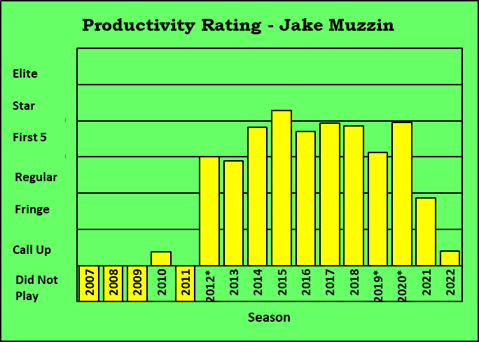
His first actual season was 2010-11, where he played a handful of games for Los Angeles. He did not play in the NHL in 2011-12 and then had his first good season in 2012-13 (PR-Score 6.01). In his subsequent season, he had a PR-Score of 5.79, making ST-Score 11.80.
ST-Category groups players based on their ST-Scores. As I want to focus on players who had good starts and/or good careers, I decided to put the top 15% of players in group ST_A, the next 15% in group ST_B, and everybody else in group ST_C. The ST-Score to ST-Category mapping rules are shown below.

By the skin of his teeth, Jake Muzzin’s career start places him in the ST_B category.
Career Quality Statistics: CA-Score and CA-Category
The group of players who can be used for career quality statistics is a subset of the group used for career starts because I wanted players who had at least six usable seasons. 337 players who had measurable career starts also have measurable careers.
My first idea for CA-Score was to use a player’s average season PR-Score. For Muzzin, that was 5.87, which is the top of the PR-Regular category. A quick look back at his career Productivity Rating chart shows that 5.87 would be much too low for Muzzin.
His chart shows he has had one PR-Star season, six PR-First5 seasons, and one PR-Regular season (that was close to being a PR-First5 season). How on earth does that produce a CA-Score in the “Regular” range? Because it was based on the average PR-Score of all his seasons, which include 2010-11, 2021-22, and 2022-23.
While this approach was technically accurate, it was unfair to players who played a couple of very short seasons. Lots of players get one or more short seasons at the start of their careers, some get a short season at the end of their careers, and some get an injury-related short season in the middle of their careers.
To increase the accuracy of CA-Score, I decided to exclude any season in which a player played less than one-third of the scheduled games. I also adjusted a player’s PR-Score to a full season’s worth of games in any season where he played more than one-third of the games but less than the full schedule.
Jake Muzzin played 74 of the 82 scheduled games in 2017-18 with a PR-Score of 7.87. His 82-game-adjusted PR-Score for that season is 8.67. Muzzin has played twelve seasons and played more than one-third of the season in ten of them. In those ten seasons, his average adjusted PR-Score is 7.58, which is his CA-Score. That is in the upper region of the First5 category, and that is an appropriate reflection of his career.
I want to stress that I didn’t go through this effort to improve Muzzin’s score, as I don’t know Jake Muzzin from a cornbread muffin and he has recently played for the wrong team. I went through this effort for all players because there were several players whose CA-Scores clearly undermeasured their careers. I did this extra work to increase the accuracy of the career quality statistics.
The CA-Score to CA-Category mapping rules are shown below.

Muzzin is at the top of the CA_B group. One final datum for him: he was 23 years old in his first good season.
EASILY
EASILY (Early Age Success Is Like Yeast) is a playful initialism that describes the casual observation made at the start of this article: the players who had better careers had good career starts at an early age.
Is EASILY an accurate observation, or is it overly influenced by “survivor bias”? Survivor bias happens when we focus on who is remaining (players who had good careers) rather than those who were removed (players who had good starts but did not have good careers).
I will use Sankey diagrams (I love Sankey diagrams!) to show how career starts and career quality are related and will show these data for players in two-year age groups to show the influence of age. If you are a number person, a section at the end of this article titled “Start to Career Counts” will be for you.
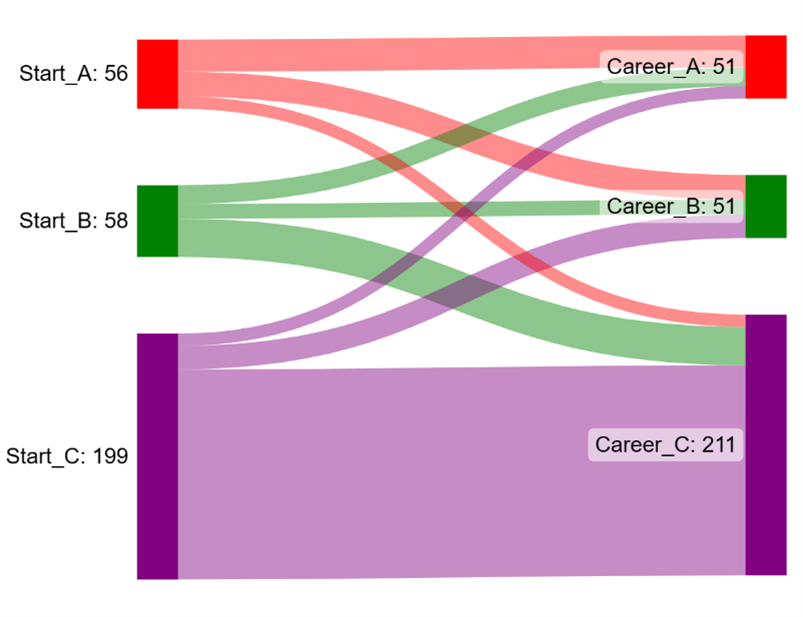
1- Start to Career Evolutions, Ages 18 to 25
All Sankey diagrams in this article were made using SankeyMatic.com. It is quite easy to use (source: I figured out how to use it).
Diagram 1 shows the evolution of career starts to career quality for players aged 18 to 25 in their first good season. The total number of players in this chart (56+58+199) is 313 because 24 players started their careers when they were over the age of 25.
In general, the chart shows what we expect it to show. Very good starts (Start_A) tend to evolve into very good careers (Career_A), and mediocre starts (Start_C) tend to evolve into mediocre careers (Career_C). It also shows that there are exceptions: sometimes a great start evolves into a mediocre career, and sometimes a mediocre start evolves into a great career.
Now let’s look at the players whose first good season came at ages 18 or 19: they will be referred to as the 18-19 group.
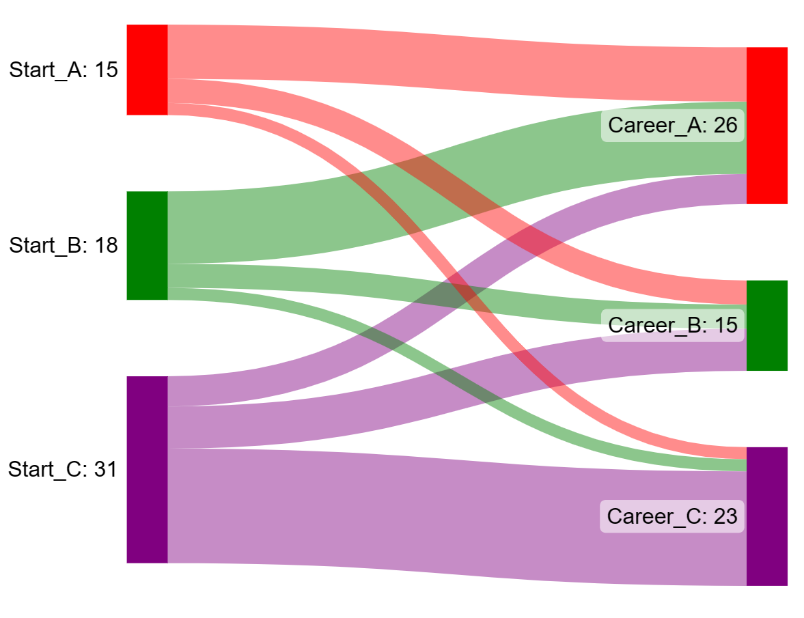
2 – Start to Career Evolutions, Ages 18 to 19
Overall, players in the 18-19 group had very good (Start_A) or good starts (Start_B) and tended to have very good careers (Career_A). The biggest disappointment in young players who started their careers well must be Pierre-Luc Dubois, who went from Start_A to Career_C. Six years into his career, he is playing no better than he did in his first season.
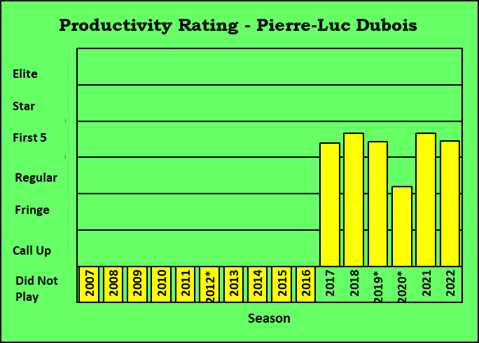
Five players are pleasant surprises, having evolved from Start_C to Career_A. They are: Ryan O’Reilly, Mika Zibanejad, Sean Couturier, Dougie Hamilton and Dylan Larkin.
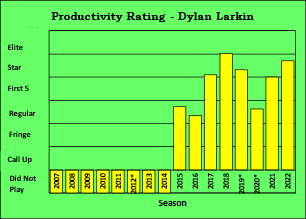
A comparison of the first Sankey diagram (for 18- to 25-year-old players) and the second Sankey diagram (for 18- to 19-year-old players) shows important differences. Less than 50% of the age 18-19 players were in ST_C and more than 60% were in CA_A or CA_B. Players who had their first good season in their teenage years have been very good players, by and large. They have had more success, proportionally, than the players who were in their twenties when they had their first good season.
Next up are the players whose first good season came at age 20 or 21 (group 20-21).
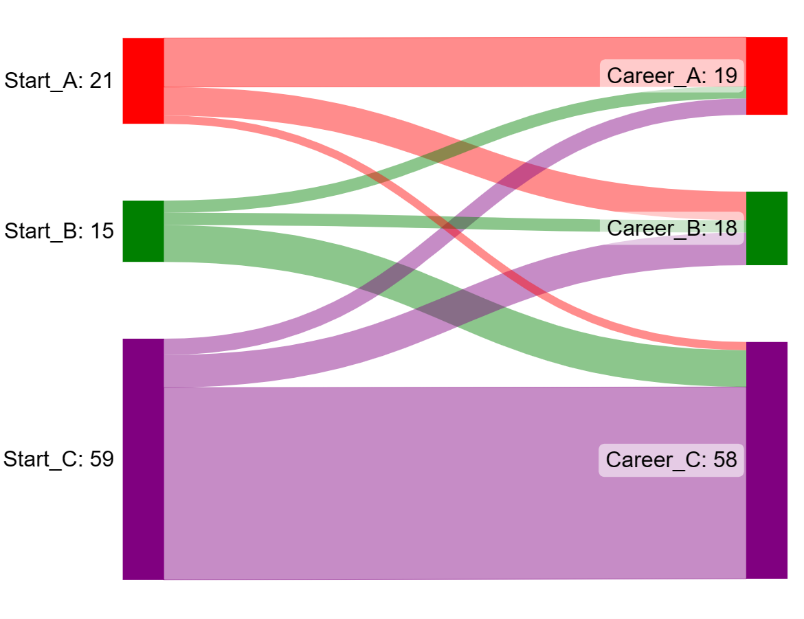
3 – Start to Career Evolutions, Ages 20 to 21
The changes in career evolutions from the 18-19 group are not huge, but neither are they trivial. For the 18-19 group, 48% of the players had ST_C starts: for the 20-21 group, 62% of the players had ST_C starts. Also, the 18-19 group had 64% of players end up in CA_A or CA_B, whereas only 39% of the 20-21 group had those types of careers.
Darnell Nurse (EDM) is one of four players in this age group who evolved from ST_C to CA_A. His first good season was 2015-16, and he missed 35 games in his subsequent season due to an ankle injury. His PR-Score for that subsequent season is both “lower than it should be” and “an accurate representation of what he did in that season.”
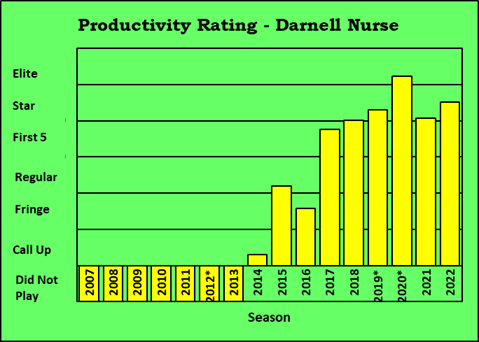
Next up are the players whose first good season came at age 22 or 23 (the 22-23 group).
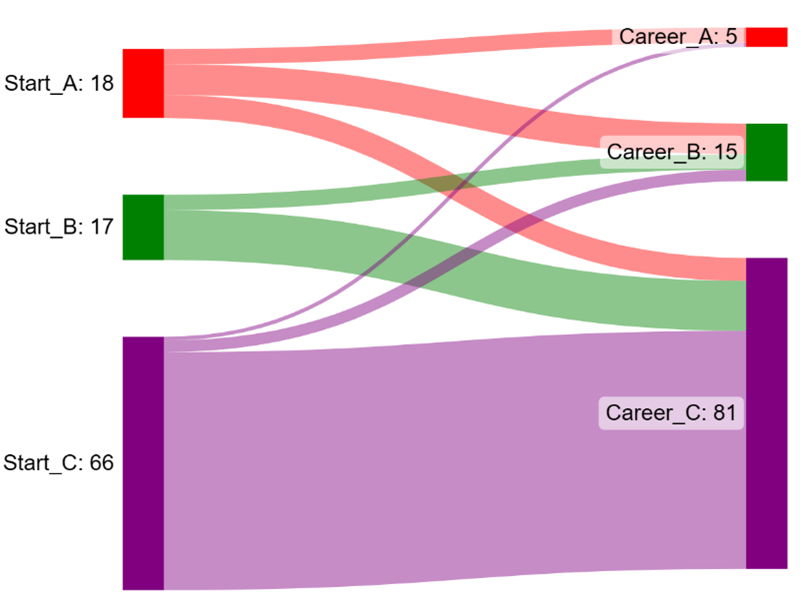
4 – Start to Career Evolutions, Ages 22 to 23
Compared to the 20-21 group, ST_A and ST_B are much smaller, and 80% of the players in this group ended up in CA_C. Only 5% of players in this group went on to have CA_A careers: specifically, they are Roman Josi, Mark Stone, Jack Guentzel, Ryan McDonagh and Jared Spurgeon.

One last shout-out to our new statistics exemplar, Jake Muzzin. In his age group, he is in the top third of career starts and the top quarter of career quality.
Finally, let’s look at the players whose first good season came at age 24 or 25 (the 24-25 group).
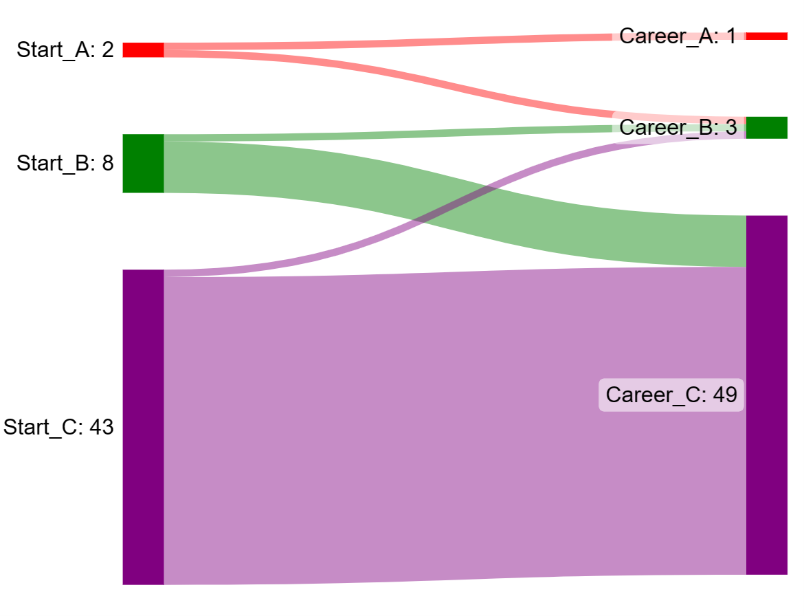
5 – Start to Career Evolutions, Ages 24 to 25
If you haven’t had a good season by age 24, you are unlikely to have either a very good start or a very good career. Artemi Panerin and Mattias Ekholm were both 24 when they had their first good season: Panarin’s career is rated CA_A, while Ekholm has a CA_B career.
Panarin played in Russia until he was 24. Ekholm played handfuls of games in 2010-11 and 2011-12. He started playing regularly in 2012-13, but his first good season came in 2014-15.
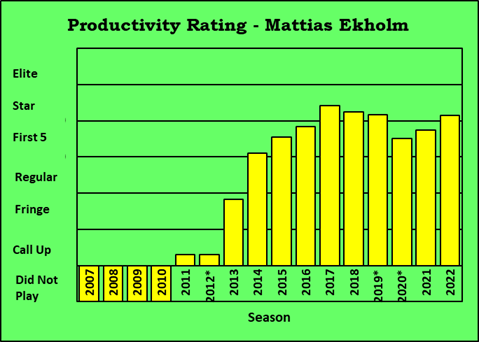
Up and Comers
There are 101 players who “had a good start” to their careers in 2019-20, 2020-21 or 2021-22 and were 25 or less when they had that first good season. Fourteen are in the ST_A category and thirteen are ST_B. In the table below you will see the names of those 27 players, sorted in order of their ST-Score (Fox has the highest ST-Score of the group, Pius Suter the lowest).
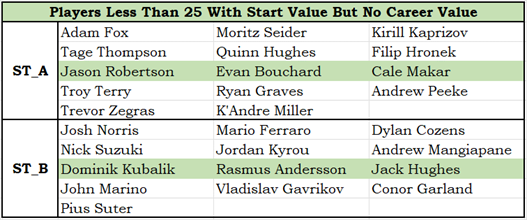
There are five teams that have strength in numbers when it comes up their young players. Detroit (Seider, Kubalik and Suter) and New Jersey (Graves, Hughes and Marino) each have three players on this list. Anaheim (Terry, Zegras) and the New York Rangers (Fox, Miller) each have two on the list, and they are both ST_A.
Start to Career Counts
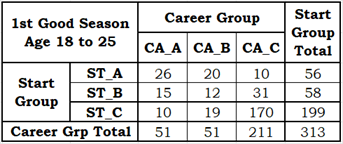
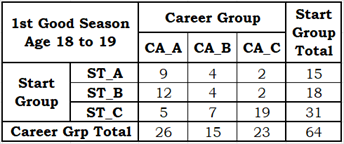
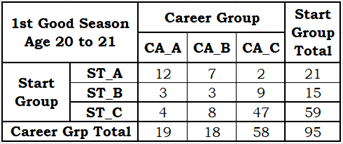
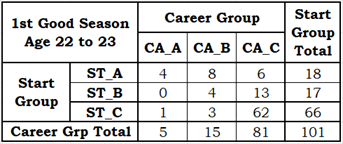
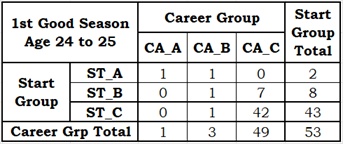
Summary
In writing this article, I confirmed that young players who have good starts to their careers tend to go on to have good careers. It isn’t a sure thing, but it’s a pretty sure thing.
I also learned that players who have their first good season after the age of 23 have a small chance (less than 10%) of having a good career. I had thought that most of these players would be Russians who had to play in the KHL for a while before starting in the NHL, and that was completely inaccurate. Most of them were North Americans.
This data should not be construed as saying that all players should start playing in the NHL in their teenage years. Most teenagers are not ready to play in the NHL. The data shows those who played as teenagers were already quite good players.
Related Articles
